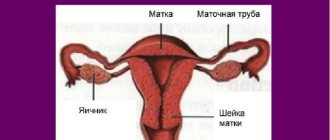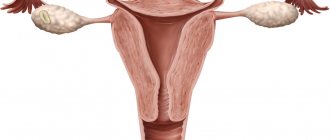All layers of a woman’s reproductive organ, which make up her wall, are responsible for a certain role in the process of growth and development, life and disease in women. The endometrium is the internal proliferative layer lining the uterine cavity. The hormonal cycle and its phase determine the degree of endometrial thickening. It is also important to recall why this layer of the uterine wall thickens.
The most important point is pregnancy. The fertilized egg moves through the fallopian tubes into the organ cavity, where the thickened inner layer is ready to receive it for the further development of pregnancy. The fertilized egg is attached to the front wall; localization of the place where the egg is attached to the rear wall is considered more favorable.
Myometrial thickening during pregnancy is normal. Because in order to carry a pregnancy to term and then give birth to a child, you need sufficiently powerful muscle mass for the uterus. Therefore, during pregnancy, thickening of the myometrium of the entire uterus or local thickening of the muscle wall occurs. It should be noted that local thickening is normal only until a short period of pregnancy, up to about 5 weeks. Next, the process of increasing the muscle mass of the uterus should occur evenly throughout the entire organ. You should be very careful about this factor, since the expression: “a disease is easier to prevent than to treat” must always be remembered.
Local thickening of the myometrium can be caused by several factors:
- Pregnancy up to 2 months can be considered a variant of the normal development of pregnancy;
- Hormonal status of a woman. The examination can be repeated or performed on another day of the cycle to exclude the disease;
- Pregnancy after 6 weeks, occurring with pathological abnormalities: pregnancy threatening to be terminated in the early stages, for example.
- Various diseases of the uterus. This includes pathological conditions such as endometriosis, adenomyosis, endometritis, and fibroids.
In the first few weeks of pregnancy, local thickening of the myometrium of the anterior wall of the uterus can often be observed. This condition does not indicate a disease; it only indicates that pregnancy has taken place and the fertilized egg has begun to implant in the thickened inner layer of the uterus. Further, this local thickening of the myometrium of the anterior wall or posterior wall of the uterus in the normal course of events should disappear, and the myometrium will proliferate evenly.
Threatened miscarriage
If there is a threat of miscarriage (miscarriage) at a later stage, thickening of the myometrium both on the anterior wall and on the posterior wall of the uterus, as a rule, is combined with uterine hypertonicity. The ultrasound picture of myometrial hypertonicity is characterized by the following factors:
- Local thickening of the myometrium is clearly visible against the background of the pathological shape of the embryo;
- A violation of the contour of the uterus along the outer line is often visible - part of the wall is raised;
- A local thickening of the myometrium is clearly visible on the posterior wall of the uterus.
The woman’s subjective complaints also indicate the presence of a threat to pregnancy and hypertonicity (pathological tension of the muscular frame of the uterine wall) as additional factors to the ultrasound data, which indicate the presence of a threat to pregnancy and hypertonicity (pathological tension of the muscular frame of the uterine wall):
- Frequent aching pain in the lower abdomen.
- Often pain in the lower abdomen is accompanied by pain in the sacrum and lumbar back.
- Vaginal discharge that appears against the background of these pains: bloody or streaked with blood.
Symptoms, types and dangers of low placentation
Low placentation is a pathology that does not have any symptoms at an early stage. Only in the later stages may a woman notice nagging pain in the lower abdomen and the appearance of blood. By this time, with constant monitoring, the problem has already been identified. The location of the placenta is visible on the first planned ultrasound, then the dynamics of its migration are monitored.
There are 4 degrees of presentation:
- the child seat is attached from below at a distance of less than 3 cm from the internal pharynx;
- the placenta is localized near the internal os, but does not block the baby’s exit;
- the lower part of the organ covers the pharynx, the center and top are localized at the top and bottom of the uterus, the location is asymmetrical;
- the exit is completely blocked by the main part of the placenta, its edges are attached to the walls of the uterus.
Low placentation can be characterized by fastening of the baby's place along the posterior or anterior wall of the uterus. The difference is that in the first case the prognosis is more favorable - the localization of the placenta may change to a higher one. In the second case, as the fetus grows, the placenta will most likely sink even lower, which can lead to the following complications:
- overlap of the uterine os;
- incorrect position of the fetus, entanglement of the umbilical cord;
- fetal hypoxia;
- premature placental abruption;
- risk of bleeding during childbirth.
There are risks for women too. During the expulsion of the placenta, the pregnant woman does not always feel discomfort; the blood may not come out, but may remain in the uterine cavity. Uteroplacental apoplexy occurs. In this case, an urgent caesarean section is necessary, the uterus is completely removed. Untimely assistance threatens the woman’s life.
Hormonal changes
Local thickening of the uterine wall (myometrium) is often observed in women in middle age. This is approximately from 30 to 45 years. The hormonal landscape changes over the course of life, additional diseases, previous operations or pregnancies. All these factors leave traces in the muscle layer in the form of small local thickenings. They have a nodular structure, the location can vary and are found throughout the body of the uterus: on the back wall, the front wall or in the upper part of the uterus. The factor of changes in the intensity of hormone secretion and changes in their ratio depending on the woman’s age must be taken into account and regularly monitored by a specialist. This is necessary in order to promptly notice the development of fibroids in case of possible growth of nodes in the anterior or posterior wall of the uterus.
Reasons for incorrect localization of a child's seat
Cases when the baby's place is attached to the side walls of the uterus are not uncommon. This is not scary; such attachment is not considered pathological. Anterior placenta previa, or more precisely, its attachment to the anterior wall (see photo) requires more careful observation. Low attachment is considered especially unfavorable, when the internal os is partially or completely blocked.
Reasons for attachment of the fertilized egg to the anterior wall of the uterus or close to the uterine os:
- inflammatory processes or operations on the uterus that have changed its inner layer;
- endometriosis of the cervix (hormonal disease characterized by proliferation of the mucous membrane of the organ);
- myoma (fibroids) of the uterus (benign tumor);
- multiple pregnancy;
- pathology of the uterus (inverted or curved uterus);
- numerous births;
- presence of a cesarean section scar;
- history of abortion;
- The woman is over 40 years old.
Endometriosis of the uterine body
Internal endometriosis (adenomyosis) is the most common localization of endometriosis. Clinical manifestations of endometriosis of the uterine body vary depending on the degree of spread of the process into the myometrium. It is usually customary to distinguish the main forms of the disease:
- Diffuse form;
- Focal or nodular form.
With the disease, a woman complains of spotting outside of menstruation. The menstruation itself is so profuse that it can take on the character of hemorrhage and is accompanied by painful sensations.
The nodular form of the disease is characterized by almost the same subjective complaints, but an objective examination reveals numerous local thickenings of the myometrium, the uterus is sharply painful on palpation.
Other diseases of women characterized by local thickening of the myometrium may be:
- – inflammation of the inner membrane caused by infectious agents;
- Tumor formations of various etiologies. These can be benign as well as malignant.
Forecast
The detection of local thickening of the uterine wall (myometrium) in itself is not necessarily a sign of pathology, but in combination with the above factors, it can pose a serious threat to a woman’s health.
In order for a woman to feel healthy, it is necessary to regularly see a gynecologist for preventive purposes. This should be done at least once every 6 months, even without any complaints. If there are any signs of the disease: pain, discomfort, itching, discharge, bleeding outside of menstruation, then this is definitely a reason to consult a doctor immediately!
Anything can happen to a woman during pregnancy. Any illness is a direct threat to the life of the mother and her unborn child. Myometrial hypertonicity is one of the most critical conditions of a woman during pregnancy, and every second expectant mother faces it. In this article we will figure out why the uterus becomes toned, what to do about it and how to prevent the dangerous consequences of this condition.
The myometrium is the muscular lining of the uterus, which is located between the serosa and the endometrium. Normally, the myometrium should be relaxed; it becomes toned only under the influence of factors influencing it. Normal contractions occur during menstruation and during childbirth, when the hormone oxytocin is actively produced. All other factors that provoke myometrial contractions, especially during pregnancy, should alert the woman. Due to contractions of the myometrium during pregnancy, a miscarriage may occur and premature labor may begin.
The fact that everything is in order with a woman’s health can be indicated by the homogeneous structure of the myometrium. This muscular layer of the uterus should consist of 3 fibers:
- Subserosal fibers are strong longitudinal fibers that connect the myometrium to the perimeter.
- Circular - vascular fibers that reach maximum density in the uterine cervix.
- Submucosal – internal fragile fibers.
Heterogeneous myometrium during pregnancy is a reason to begin a thorough examination and appropriate treatment. Why it may be diagnosed:
- the woman has previously had many abortions;
- she had given birth several times before;
- a hormonal imbalance has occurred in the woman’s body;
- there was surgery on the uterus;
- previous births ended in caesarean section;
- constant exposure to stressful situations.
If the myometrium is heterogeneous during pregnancy, then uterine hypertonicity may occur, due to which spontaneous abortion may occur or labor will begin earlier than necessary. To prevent all these negative consequences, a woman must:
- timely take a blood test to detect the level of certain hormones responsible for the safety of pregnancy;
- be constantly monitored by your doctor so as not to miss the onset of the inflammatory process in the organs of the genitourinary system;
- You need to lead an absolutely healthy lifestyle and avoid stressful situations whenever possible.
Causes
During a routine examination in a gynecologist's office, a diagnosis such as frequent uterine contractions is made very often. The course of this symptom can be harmless or, conversely, dangerous for the health of the expectant mother and child. The reasons for tone can be very different. During pregnancy, the female body is rebuilt and works differently, not as it always has. The behavior of the uterus is influenced by both external and internal factors:
- diseases of the uterus;
- presence of chronic diseases;
- abnormal shape of the uterus;
- hormonal deficiency;
- repeated abortions or uterine surgeries;
- bad habits;
- poor sleep, stressful situations;
- large fruit;
- multiple ovarian cysts;
- polyhydramnios.
- infantility of the uterus (small size, underdevelopment).
A more precise cause can be determined after an ultrasound examination. The doctor writes a referral for blood tests to determine hormone levels.
How to properly prevent myometrial hypertonicity is a question of interest to many pregnant women.
Myometrium during pregnancy: normal
During pregnancy, diffuse changes in the myometrium occur because the uterus increases in size due to the growing fetus. The myometrial fibers gradually lengthen and thicken. This is already noticeable in the very first weeks of pregnancy:
- at week 4, due to changes in the myometrium, the uterus acquires the size of a chicken egg, taking on the shape of a pear;
- at week 8, the uterus, due to the enlargement of the myometrium and the growth of the fetus, reaches the size of a goose egg, taking on the shape of a ball;
- at week 10, the uterus increases 3 times compared to the indicators at week 8;
- at 12 weeks, the myometrium develops, and the uterus becomes 4 times larger compared to its original size (its size can be compared with the size of the head of a newborn baby);
- at week 20, the myometrial fibers no longer normally thicken or lengthen, they simply stretch.
Normally by the end of pregnancy:
- the thickness of the uterine walls is 1.5-0.5 cm;
- the length of the uterus reaches 38 cm, although its original size is 7 cm;
- the width of the uterus at the end of pregnancy normally corresponds to 25 cm (initial value 6 cm);
- the volume of the uterus before childbirth becomes 500 times greater than the volume of the uterus in the normal state;
- the weight of the uterus before birth is approximately 1.2 kg (not taking into account the weight of the fetus and membranes), and before pregnancy it is 50 g.
The remaining indicators, which are significantly lower or higher than normal during pregnancy, are a direct indication for hospitalization of the expectant mother.
Myometrial hypertonicity during pregnancy
If an expectant mother is diagnosed with hypertension, there is no need to perceive it as a terrible disease, because it is not one. Myometrial hypertonicity is the main symptom of the fact that the muscular layer of the uterus is very tense, which should not normally happen during pregnancy, because contractions of the uterus may occur, which will provoke premature birth or miscarriage.
That is why, during ultrasound examinations, diagnosticians must determine the thickness of the myometrium in order to know whether there is a threat of miscarriage.
Causes of myometrial hypertonicity during pregnancy
Due to what factors can the myometrium become hypertonic during pregnancy:
- A woman produces insufficient progesterone.
- An inflammatory process occurs in the organs of the genitourinary system (most often the cause is endometriosis).
- Surgical interventions in the uterus that took place before pregnancy.
- There are neoplasms (tumors, cysts) in the uterus or appendages.
- The walls of the uterus are overstretched due to the fact that the woman has multiple pregnancies.
- The expectant mother is constantly exposed to severe physical stress and injury.
- The woman is in a state of severe emotional shock.
- A pregnant woman has diseases of internal organs and systems affecting the uterus.
- Problems with the myometrium occur in older women.
- Problems with intestinal motility can cause myometrial hypertonicity during pregnancy.
Myometrial hypertonicity: localization and symptoms during pregnancy
Hypertonicity is localized in different areas of the myometrium:
- Hypertonicity of the myometrium along the anterior wall during pregnancy is a sign that the process of bearing a child occurs with complications. Very often, the expectant mother feels pain in the lower abdomen, in the perineum, and has a frequent urge to empty her bowels and bladder. With hypertonicity of the myometrium along the anterior wall during pregnancy, uterine bleeding is often observed.
- Hypertonicity of the myometrium along the posterior wall during pregnancy can be asymptomatic for a long time. In the later stages, he may only feel fullness in the perineum and pain in the lower back.
- A pregnant woman will feel 100% hypertonicity of the entire uterus, because with such a pathology the uterus seems to turn to stone, resembling a large ball in appearance. This is a very dangerous symptom that should be reported to your doctor immediately.
Why is myometrial thickening dangerous during pregnancy?
Thickening of the myometrium at different stages of pregnancy, as we mentioned earlier, can be very dangerous for the life of mother and child:
- The worst thing that can happen in the early stages is a miscarriage. Uterine hypertonicity is one of the most common causes of spontaneous abortion.
- Starting from the 2nd trimester, uterine hypertonicity can cause oxygen starvation of the fetus, which in turn will lead to malformations of the child’s internal organs and systems.
- In the 3rd trimester, due to hypertonicity of the myometrium, premature birth occurs. The baby may be born prematurely, and the mother will develop isthmic-cervical insufficiency, and placental abruption will occur, which can ruin the life of the child inside the womb.
- Hypertonicity of the myometrium before childbirth will not result in anything bad for either the mother or the child. On the contrary, contractions of the uterus will prepare it for labor.
What to do with myometrial hypertonicity during pregnancy?
If the thickness of the myometrium exceeds the norm during pregnancy and periodically makes itself felt, then you can perform some exercises to alleviate your condition:
- Get on all fours, arching your back and raising your head. Hold in this state for 1 minute, and then arch your back and lower your head. By doing this exercise, your uterus will be in a state of weightlessness, which will help it relax. After you have done 2-3 sets, sit in a chair and try to completely relax. Drink tea with lemon balm and honey, turn on pleasant music.
- Wear a bandage and eat as many foods as possible that contain magnesium and vitamin B.
- Rub your belly every morning and evening while lying in bed, completely relaxed.
- If your doctor prescribes antispasmodic drugs and the hormone progesterone, you will need to take them on a schedule and maintain strict bed rest so that contractile activity of the uterus is minimal.
Important! All of the above can be done at home on an outpatient basis. If bleeding or severe nagging pain appears, call an ambulance to be taken to the hospital for hospitalization.
Listen to your body every minute, because by some symptoms you can accurately determine for yourself whether everything is okay with you and your baby. At the slightest suspicion of pregnancy complications, immediately go to the doctor to avoid fatal consequences.
In early pregnancy
Myometrial hypertonicity at the beginning of pregnancy indicates that the woman’s body does not produce enough progesterone or there is an excess of male hormones.
The reason for increased uterine tone in the second trimester is:
- impaired fat metabolism;
- constant stress;
- excessive physical activity;
- inflammatory diseases of the reproductive system;
- magnesium deficiency;
- large fetal size;
- multiple pregnancy.
Severe toxicosis, accompanied by profuse vomiting, leads to frequent contractions of many muscles, including the uterus. The most dangerous phenomenon that can accompany pregnancy is Rh conflict, which causes fetal rejection; a clear symptom of this is the tone of the uterine myometrium.
There are reasons that cause increased tone that are not at all dangerous, for example, severe gas formation in the intestines. Painful sensations are associated with gases that press on the walls of the uterus. In this case, you need to exclude celery, garlic and salty foods from your diet.
Video: “Why does uterine hypertonicity occur during pregnancy?”
Endometrial hyperplasia, or thickening of the lining of the uterus, affects many women in different age groups. This occurs due to an imbalance of female hormones - estrogen and progesterone.
In medical terminology, thickening of the uterus is called endometrial hyperplasia. The endometrium is the lining of the uterus that grows and thickens every month in sexually mature women. It is reset during menstruation in the absence of pregnancy. All changes in the uterine mucosa are associated with female sex hormones - estrogen and progesterone.
Estrogen builds or thickens the lining of the uterus, and progesterone controls its growth. In the middle of the cycle, ovulation occurs and the egg is released from the ovary. If the egg is not fertilized, it can lead to a drop in hormonal levels as a result of regular menstruation. The unfertilized eggs and uterine lining are then shed through menstrual blood.
Sometimes, due to reasons such as unhealthy lifestyle, certain health problems and stress, the menstrual cycle becomes irregular. If this condition recurs, it may also be a sign of some problem in the uterus. Endometrial cells that are not shed can accumulate in the lining, causing the uterine wall to thicken. In the following paragraphs, let's discuss the causes, signs and treatment options for this uterine disease.
Causes
Any imbalance between hormones (high estrogen and low progesterone) can lead to unusual or excessive cell growth in the inner glandular lining of the uterus. Uncleaned and growing uncontrollably, lining cells tend to grow abnormally, leading to the progression of uterine cancer. It can be life-threatening and, if not properly diagnosed and treated, can prove fatal. There are various reasons due to which hormonal imbalance can occur. Some of the factors that can lead to this health problem are described below.
- Climax
- Irregular menstrual cycle
- Family history of obesity
- Diabetes
- Bunch of diseases
- Hormone replacement therapy (HRT)
Symptoms
Being an internal organ, the thickening of the uterine wall cannot be physically noticed. However, there are symptoms that can be observed that should promptly consult a doctor. These symptoms should not be ignored and should be brought to the attention of the gynecologist to avoid unwanted complications.
- Pain in the lower abdomen
- Intense spasms
- Spotting or bleeding between periods
- Excessive vaginal discharge that may be smelly or discolored
- Heavy and/or long menstrual cycles
- Feelings of warmth
- Mood swings
Call your doctor right away if you experience serious symptoms such as severe abdominal pain, changes in level of consciousness, and tachycardia (rapid heartbeat).
Treatment
Treatment depends on the severity of the disease, which is determined by a variety of tests. It is necessary to visit a gynecologist for a correct diagnosis and treatment of this uterine disorder. To check, a cytological smear is usually done, which helps identify any cellular changes in the cervix, followed by an assessment of the uterus and endometrium. Mentioned below are some other diagnostic tests that are performed to evaluate the intensity of endometrial hyperplasia.
- Cervical smear:
A simple and relatively painless test in which a sample of the woman's cells is taken and examined under a microscope to check for signs of cancer or other changes that may indicate any abnormalities. - Ultrasound:
Ultrasound uses sound waves to produce an image of the uterus. This allows us to determine the thickness of the endometrium and the spread of infection. - Biopsy:
A uterine biopsy involves inserting a narrow tube inside the uterus to take a sample of cells. These cells are then examined under a microscope to detect the presence of cancer. - Curettage:
This procedure uses a special device called a “curette” to loosen and remove a sample of tissue from the lining of the uterus. This sample is sent to a laboratory for testing. - Hysteroscopy:
A device like a narrow telescope is inserted into the uterus and is used to look for areas that appear abnormal. The cells are removed and sent for diagnostics.
Endometrial hyperplasia can be treated with medications or surgery. Drug treatment involves the use of the hormone progesterone, which causes shedding of the old uterine wall and prevents abnormal growth and with the help of the drug Gynodek. This will often cause vaginal bleeding. Surgery, on the other hand, involves a hysterectomy (surgical removal of the uterus). This is usually done when uterine cancer is detected.
This article provides insight into this uterine disorder, how and when it can occur, and the role hormones play. Endometrial hyperplasia itself is not cancerous, but women diagnosed with this condition are considered to be at higher risk for contracting cancer. It can be treated and early diagnosis, timely intervention and proper treatment for this uterine abnormality will help you lead a healthy life.
In the myometrium, local thickening can be either on the anterior or posterior wall. Why is this factor dangerous for pregnancy, and what are the acceptable deviations?
Physiological aspects
Thickening of the uterine wall occurs periodically in women due to the characteristics of the menstrual cycle. Each phase of the cycle is accompanied by the production of certain hormones in varying concentrations. Estrogen and progesterone are produced in the female body by the genital organs and directly affect the lining of the uterus.
The uterine lining thickens monthly in every woman who has reached reproductive age. Each cycle the endometrium prepares for the expected pregnancy and implantation of the fertilized egg. In the absence of this event, the endometrium is forced to be rejected and evacuated from the uterine cavity. Hormonal compactions occur due to estrogen, while progesterone controls their growth.
The release of the egg from the membranes, called ovulation, continues with its movement through the fallopian tubes, where fertilization should take place. If this does not happen, the unfertilized female reproductive cell enters the uterus, which is accompanied by a drop in hormonal levels. This also mediates menstruation - the shedding of the uterine lining and unfertilized egg through the blood.
Why does the myometrium thicken?
In some pregnant women, diagnostic tests reveal thickening of the myometrium. In gynecology, the muscular layer of the uterus is called the myometrium. Its thickness varies depending on what stage of the menstrual cycle a woman is at or during pregnancy. To prevent the development of pathological processes, you need to know what caused the thickening of the myometrium.
Quite often, local thickening occurs on the anterior wall of the uterus. This is due to hormonal disorders or gynecological, obstetric and even endocrinological diseases of the woman.
Changes can be detected during menstruation, which gradually disappears. The level of progesterone and estrogen changes, which contributes to normal fluctuations in myometrial thickness.
Thus, phase 2 of the menstrual cycle can affect local thickening of the myometrium up to one and a half centimeters, and at the end of the menstrual cycle the thickness can be only a couple of millimeters.
The myometrium may also thicken due to the duration of pregnancy. This is due to the fact that the fetus is enlarged and hormonal and physiological changes occur. Using ultrasound, you can detect not only normal thickening, but also identify pathologies such as:
- uterine fibroids;
- threat of miscarriage;
- adenomyosis;
- endometriosis.
Return to contents
Etiology of the condition
A dense uterus, when detected during a gynecological examination, is an indication for an ultrasound examination. Thickening of the walls of the uterus is called endometrial hyperplasia in clinical practice and is exclusively instrumental indicators. Hyperplasia can be detected on the posterior wall of the uterus or in any other part of it with the following diseases:
- Uterine fibroids. Tubercles in the muscular layer of the uterus occur in almost every woman who has crossed the threshold of 30 years. They vary significantly in size and location and can be located both in the body and in the cervix. Seals in the uterus in the form of nodes are of myomatous origin, but can grow into both the serous and mucous layers of the uterus. Any subserous node is dangerous because it grows into the abdominal cavity.
Myomatous compaction in the uterus, when it reaches a certain size, is clinically manifested by menstrual disorder, dysfunctional uterine bleeding, and severe pain. If these symptoms are ignored and there is no treatment, there is a risk of urination and defecation problems, and there is a high probability of infertility.
With small nodules, gynecologists usually do nothing, but only observe for some time. Small tubercles in the myometrium or on the surface of the uterus are prone to self-resorption.
- Endometritis is an inflammatory process. The pathology begins with minor tingling in the abdomen, which is then accompanied by discharge from the genitals with an unpleasant putrefactive odor. Further, symptoms of general intoxication increase: fibrile temperature, severe weakness, dyspeptic disorders. Gynecological bimanual examination reveals fibrous dense areas on the anterior wall of the uterus or in other areas, a painful organ on palpation, and its significant enlargement.
- Adenomyosis of the uterus is also called internal endometriosis. Signs of the disease are detected during examination using an ultrasound wave, and some symptoms indicate it. Upon palpation examination, the uterus is uneven; it may be lumpy or unevenly enlarged. Menstruation in women is scanty and spotting. Patients complain of poor health, a constant desire to drink, and significant weight loss. Sexual relations do not bring pleasure to women; sexual contacts are accompanied by pain.
Adenomyosis affects the inner lining of the uterus, it takes on a cellular appearance and becomes abnormally thick. Thickening of the posterior wall of the uterus compresses the genital appendages and disrupts their function.
There are some other reasons why the wall of the uterus thickens, but they are directly related to the physiological state of pregnancy.
Why is there a threat of miscarriage?
After an ultrasound examination performed in the first trimester of pregnancy, the specialist records local thickening of the myometrium along the anterior wall of the uterus. The thickening indicates pathological disorders after 5 weeks; before this period, the thickening indicates implantation of the fertilized egg, which is not a pathological process.
The threat of miscarriage may arise due to the following reasons:
- if the embryo has a drop-shaped or scaphoid shape;
- if the uterus is in a state of hypertonicity;
- if the external contours of the uterus are greatly changed.
Return to contents
Consequences
Possible consequences include:
- Massive bleeding.
- Infertility.
Thickening of the walls of the uterus, what is it? This is a systemic disorder of the endometrium or myometrium, during which hyperplasia of the hollow organ occurs. It is impossible to cope with this condition on your own; consultation with a gynecologist is required. The prognosis is favorable in most cases. It is important not to delay treatment. Otherwise, there is a high risk of life-threatening and health-threatening complications.
Adenomyosis and endometriosis
Quite often, adenomyosis develops during inflammatory processes in the uterus. With this disease, the endometrium is able to grow into the layers of the uterine walls. This disease can be detected in the presence of such signs as: spotting type discharge; menstrual irregularities; presence of pain; during the study, both local and posterior can be detected. Adenomyosis is a form of endometriosis in which there is significant impairment of the muscular layer of the uterus.
The endometrium is the lining layer of the uterus. During inflammatory processes, endometrial cells are damaged and endometriosis develops. Previously, medical experts believed that this disease was a sign of certain gynecological diseases. Modern medicine has identified it as an independent nosological unit. One of the forms of this disease is, which indicates the location of inflammatory foci in the thickness of the endometrium. With endometriosis, local thickening of the myometrium along the posterior wall is often detected. This form of thickening can lead to the development of malignant neoplasms of the uterus. In this case, not only thickening is observed, but also a pronounced asymmetry of the uterus due to the development of a lesion in its wall.
Return to contents
Local thickening of the myometrium: normal or pathological?
Pregnancy is an important period in the life of every woman, however, it is often overshadowed by various troubles and complications. One of these pathological conditions of the expectant mother is thickening of the myometrium, the progression of which can lead to fetal death. That is why it is important to know the reasons for the development of this condition and the symptoms of its manifestation.
Myometrial thickening during pregnancy: normal or pathological?
One of the components of the uterine layer is the myometrium, the thickness of which can vary depending on the day of the menstrual cycle, as well as in the event of pregnancy. Particular importance is attached to identifying the cause of thickening of the muscle layer, which allows timely detection of pathological changes in a woman’s body.
One of the common symptoms that is detected in females is considered to be a local thickening of the muscle layer along the anterior wall of the uterus. However, often the thickness of the uterine wall is prone to changes under the influence of a decrease or increase in the level of hormones in the female body, or under the influence of other factors. It is for this reason that the detection of thickening of the muscular layer of the reproductive organ does not always signal any pathology.
Changes in the myometrium during pregnancy
Doctors diagnosing local thickening of the myometrium when expecting a child indicates that the woman has increased uterine tone. Of course, during the process of childbirth this is considered very important, but in other cases such increased contraction of the reproductive organ is accompanied by unpleasant painful sensations.
Local thickening of the muscle layer during pregnancy is a dangerous pathology that requires increased attention and control.
What are the consequences of uterine hypertonicity?
Hypertonicity of the uterus during pregnancy requires maximum attention. This is due to the fact that the fetus needs a normal supply of nutrients and oxygen. This significantly affects the further outcome of pregnancy. Most often, hypertonicity is accompanied by vascular compression, and the importance of these vessels lies in the fact that they contribute to the nutritional and oxygen supply of the fetus. This factor adversely affects the fetus. However, it does not always cause premature birth or miscarriage.
What are the reasons for development? Often these factors include the following:
- When hormonal levels decrease. This condition is especially dangerous for pregnancy up to 10 weeks. This is due to the fact that the placenta is just being formed during this period.
- When the level of androgens increases, the myometrium succumbs to hypertonicity.
- Diseases suffered during pregnancy. Tumors, inflammations, abortions and infectious diseases are also the cause of increased uterine tone.
- Multiple external factors also affect myometrial tone. These may include malnutrition, lack of sleep, alcoholism, smoking or constant anxiety.
- Another factor in myometrial hypertonicity is underdevelopment of the uterus or its small size.
How to properly prevent myometrial hypertonicity is a question of interest to many pregnant women.
To prevent such a condition, even when planning a pregnancy, a woman must be fully examined for all infectious diseases and eliminate existing ones.
Infections during pregnancy are fraught not only with hypertension, but also with much more dangerous effects (during childbirth, a child can acquire many rather unpleasant diseases that cause blindness or even death). In addition to hypertonicity, there is also a condition of uterine hypotonicity, which during pregnancy may not cause any inconvenience, but problems may arise during childbirth.
During pregnancy, a woman should be as nervous and physically overexerted as possible. She better learn not to worry. If the first signs of increased myometrial tone occur, you should not panic, but consult with an endocrinologist and gynecologist.
You should not think that thickening is a consequence of factors only due to the threat of pregnancy; often the cause may be a hormonal surge that remains within the normal range. Hormonal levels are corrected when visiting a gynecologist or endocrinologist. These doctors prescribe the correct treatment, thanks to which the woman does not have to worry about pregnancy.
The female body is a complex system in which all organs and systems are interconnected. For example, a lack of female hormones estrogen entails a number of diseases that affect overall well-being and fertility.
Thickening of the uterine wall is a common disease that occurs for a number of reasons and entails serious consequences.
Uterine hyperplasia
During ovulation, the released egg moves through the fallopian tubes, where fertilization can occur. If this does not happen, it enters the uterine cavity, which leads to hormonal imbalance. It is for this reason that particles of the uterine mucosa and female germ cells are released through the blood.
The uterus is a round cavity whose walls consist of three layers. The outer layer covering the uterus in the pelvis is called serous.
The thickest layer is the myometrium: it allows the uterus to contract during labor and the menstrual cycle. The endometrium is the inner mucous layer, which undergoes some changes during menstruation.
During hormonal imbalance or the development of any disease, any of the layers of the uterus may thicken. Most often, women are diagnosed with thickening of the inner layer of the organ.
The main factors provoking these changes include:
- Threat of spontaneous miscarriage.
The reasons for termination of pregnancy can be bad habits, excessive exercise. But thickening of the walls in some cases does not in any way affect the duration of pregnancy and the proper development of the fetus.
- A benign tumor of the uterus that appears due to increased levels of estrogen.
Myoma is the most common disease in which cramping pain, pressing sensations in the lower abdomen, and causeless bleeding are noted, which sometimes lead to anemia. Very rarely, a patient may complain of problems with the intestines and bladder. Advanced cases of pathology lead to infertility.
- Growth in the structures of the muscle layer.
A woman complains of frequent pain, unusual discharge and menstrual irregularities. When examining, thickening of the uterus can be detected both on the anterior and posterior walls. Untimely treatment can lead to tumors of various types and infertility.
- Inflammatory process in the endometrium.
The disease is characterized by elevated body temperature, purulent discharge, nausea, general weakness, periodic pain and vomiting. During the thickening of the uterine mucosa, fibrosis and calcification develop. The menstrual cycle is disrupted.
The main causes of hormonal imbalance, which should cause concern for a woman, include age, excess weight, taking hormonal medications, and diabetes.
Causes
Factors in the development of the disease are multiple. Among them:
Symptoms of the disease
The uterus is an internal organ, so very often it is impossible to detect any problems or changes associated with it. But there are a number of symptoms that you need to pay attention to. When contacting a gynecologist, a woman should tell her about them in as much detail as possible, which will make it easier to make a preliminary diagnosis:
- various pains in the lower abdomen;
- the appearance of cramps during the menstrual cycle;
- discharge with blood particles or bleeding during absence of menstruation;
- the menstrual cycle is painful or its duration has increased;
- the discharge has acquired an unpleasant odor;
- a surge of heat is periodically felt in the lower abdomen;
- sudden changes in mood, depression.
A visit to specialists should not be postponed if the pain does not subside after taking painkillers, and there is a rapid heartbeat even during rest.
Symptoms
Symptoms of hyperplasia are numerous. It all depends on the intensity of the process, its nature, as well as the individual characteristics of the patient’s body. Thickening may occur without visible manifestations. Among the characteristic features are:
- Pain syndrome. Localized in the lower abdomen. The intensity of pain varies: from minor discomfort to unbearable pain. Patients characterize the discomfort as “aching”, “pulling”, “shooting”. The syndrome radiates to the legs, groin area, navel, lower back.
- Menstrual cycle disorders, while periods themselves can become either too frequent or too rare. The duration of the menstrual cycle also increases dramatically.
- Bleeding of unknown origin. Typically, the amount of blood is minimal, but this is a warning sign.
- Intense premenstrual syndrome with irritability, headaches, and pain in the abdomen and chest.
- Intermenstrual discharge of unusual consistency or character. Usually with an unpleasant odor.
Symptoms develop simultaneously, which is typical for problems with the reproductive system.
Diagnostics
An appointment with a gynecologist most often begins with an oral history of the patient. The woman should tell the doctor in detail about the symptoms that worried her, when they began.
Laboratory tests begin with a cytological smear, which allows you to determine any changes in the cervix, followed by analysis of the condition of the uterus itself and the internal mucous layer.
In addition, at the discretion of the attending physician, a number of diagnostic measures can be carried out:
Also, diagnosis does not exclude a general and biochemical blood test. This helps prevent excessive bleeding during treatment or infection.
Causes
During a routine examination in a gynecologist's office, a diagnosis such as frequent uterine contractions is made very often. The course of this symptom can be harmless or, conversely, dangerous for the health of the expectant mother and child. The reasons for tone can be very different. During pregnancy, the female body is rebuilt and works differently, not as it always has. The behavior of the uterus is influenced by both external and internal factors:
- diseases of the uterus;
- presence of chronic diseases;
- abnormal shape of the uterus;
- hormonal deficiency;
- repeated abortions or uterine surgeries;
- bad habits;
- poor sleep, stressful situations;
- multiple ovarian cysts;
- polyhydramnios.
- infantilism, size, underdevelopment).
A more precise cause can be determined after an ultrasound examination. The doctor writes a referral for blood tests to determine hormone levels.
Treatment for thickening of the uterine wall
Treatment of uterine hyperplasia directly depends on the cause of the disease. For example, for adenomyosis, painkillers and birth control medications are prescribed to reduce pain and bleeding. The symptoms of the disease can be partially eliminated with the help of a spiral, which is placed for a short time. But after its removal, the signs of the disease return again.
In advanced cases, adenomyosis requires immediate surgical intervention. If heavy bleeding is observed or fibroids are suspected, complete removal of the uterus is recommended.
Doctor's prescriptions for hyperplasia
When diagnosing a benign neoplasm, hormonal drugs are prescribed, which only temporarily stop the growth of pathological nodes. Combined oral contraceptives are most often prescribed to young and nulliparous girls in whom hyperplasia is accompanied by heavy bleeding.
Thickening of the uterine wall often occurs due to hormonal imbalance, so synthetic analogues are used to restore balance. The duration of treatment is no more than three months. The patient may complain of occasional bleeding, which is considered normal.
Very often, drug therapy does not help, so the attending physician prescribes surgery:
- Curettage of the uterine cavity is carried out to remove the problem area of the mucous membrane and stop bleeding. Removed biological materials must be sent to a laboratory for testing.
- Cryodestruction is carried out to expose the affected area to low temperatures. As a result, the thickened part of the uterus is rejected.
- Thickening of the mucous membrane can be removed using a laser or high temperatures. The endometrium recovers in a short time after surgery.
Prognosis and complications
The consequences of thickening the uterine wall can be different and depend on the disease that caused this pathology. For example, advanced cases of adenomyosis can lead to iron deficiency, frequent headaches and fainting, decreased performance and memory impairment. Advanced cases of the disease most often become the cause of malignant tumors.
The uterus has a more favorable prognosis. Untimely treatment can lead to anemia, miscarriage, infertility, and heavy bleeding after childbirth. Complications of endometritis are characterized by pain in the pelvic region, inflammation of the appendages, infertility or menstrual irregularities.
Thickening of the uterine wall is considered benign, but women with this diagnosis are more susceptible to cancer. Therefore, timely diagnosis and proper therapy will help get rid of the disease and restore the woman’s health.
Useful video about endometriosis:











